|
teaching and courses
taught
link to course
vignettes
|
| Philosophy |
My approach to teaching varies depending on the context of the course. Undergraduate and graduate courses require a different approach, as do introductory (content-rich) courses and studio courses. Since Master of Landscape Architecture is a professional program accredited by an external agency, the BSLA and MLA curriculum are guided by accreditation requirements and the goal of entering professional practice upon graduation. Furthermore, almost all states require examinations leading to licensing of landscape architects, which adds a focus of professional skill development, especially in the undergraduate courses. The graduate courses are oriented toward research or large scale issues with a greater emphasis on social/cultural, environmental and planning. Given the breadth of my teaching assignments, I design the pedagogy of each course to respond the variations in scale, professional focus, and learning context. |
Content Rich Courses
Click to enlarge image icons |
For the introductory courses that I frequently teach (Principles of Site Design, Introduction to the Built Environment, History of Landscape Architecture, and Water Conservation Technologies), I adopt a model of computer assisted learning (see the Water Conservation Technologies website. I build web sites for each of these courses for several purposes. First, less experienced learners at the university need more highly structured courses to support and organize their efforts. Secondly, I provide either lecture outlines (for the courses with the largest populations) or complete presentations of text and images that the students engage before class meetings. The web site for LArc 251, Introduction to the Principles of Site Planning, is an example of a course with lecture outlines while the sites for LArc 380 and LArc 389, History of Landscape Architecture, provide more comprehensive material. The advantage of the second approach is that class meetings dedicated to traditional lectures are reduced in favor of studio activities where students apply the concepts they have learned to the solution of a new problem. |
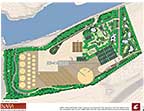
Reindustrialization graduate studio
|
In contrast is LArc 556, a graduate studio. In the spring semester of 2013 it was supported by a federal grant, involved architecture, planning and engineering students and faculty, and was product oriented. Concepts and methods were generated during the class to achieve the project results. In this case, this was a supply chain for woody biomass collection and conversion to isobutanol (for jet fuel) and the master planning of five prototypical sites (see the top image at left). The sites were brownfield or greyfield properties adjacent to communities. Re-imagining the role of these properties as community resources and environmental restoration opportunities in addition to re-industrialization presented the students with design and technological challenges consistent with contemporary practice in a collaborative setting. Rather than providing materials to these students, creative problem solving and independent research responding to emerging project needs and manipulation of data for presentation characterized faculty and student interactions. |
| |
|

Sandpoint ID studio project
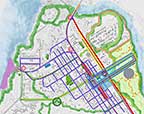
Cascade ID studio project
|
LArc 453 is an undergraduate studio that I have taught many times and features a different pedagogy than the studio described above. This studio concentrates on service-learning and outreach, with the goal of revitalizing rural communities through economic development, master planning and physical design. This is a trans-disciplinary studio in which the landscape architecture students are teamed with architecture students and supported by community agencies and citizens. The Idaho communities of Sandpoint, Cascade and Priest River have receive the sustained effort of this studio during more than one academic year (other courses in the landscape architecture, bioregional planning, and architecture programs produced complimentary outreach products for these communities as well). Working in a reality charged, public participatory environment is a terrific opportunity for students, citizens and communities alike to learn how design and planning is mediated by social and political processes.

Priest River ID studio project |
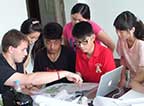
Study Abroad in China, 2013
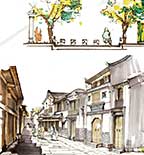
Study Abroad Studio Product
|
Broached earlier, my commitment to delivering study abroad experiences tailored to design students is demonstrated by participation in summer courses in Italy and China 11 times since 2000. Most recently, this involved a program organized by UI Associate Professor Xiao Hu, which featured the production of a master plan to increase tourism in a small Chinese town. Chinese and American students from a variety of disciplines collaborated to create a vision for the community (see the top two image at left). More than any other courses, these study abroad courses are transformative experiences for students.
Planning is underway to deliver another Italy study abroad program in the summer of 2014. |

Architecture and Landscape Architecture Team on-site in Sandpoint ID
|
I am an advocate of the integrative and multidisciplinary approach to education since this is the professional environment in which graduates will find themselves. In fact, I teach in this context to a greater degree and more consistently than any professor in my college. This is a challenging teaching position that requires good interpersonal relationship skills and a broad background in planning, landscape architecture, natural science and technology. My teaching is based on techniques that integrate concepts from a variety of disciplines. Table 3, at the end this page, demonstrates sustained teaching effectiveness according to one measure, student evaluations of teaching. See the promotion documents for the semester reports. |
| |
As suggested above my overarching philosophy is that contemporary problems associated with the development of human settlements, regardless of their extent, are more complex than any single discipline can address. In fact, single discipline approaches create as many problems as they solve. An ecosystem services approach that addresses cultural, environmental and economic aspects of urbanization presumes that professionals collaborate to create integrated systems that achieve human aspirations while sustaining the ecosystems. Healthy ecosystems are the reservoir of essential biodiversity as well as human products and services. I believe that understanding the relationship between ecosystem extent, health, and configuration and the development of human systems is critical to solving problems ranging from social justice, species extinction, and sustained economic growth to mitigation of climate change. I’m passionate about the opportunities to explore these relationships with my students through theory courses, technology courses, and studios. Even construction detailing courses (which I haven’t taught for a few years) offer choices of sustainable materials and technologies in service of a balance between humans and the environment. |
| |
Landscape architects are predominately generalists. That is to say that they approach planning and design problems holistically. This is an unusual orientation in a society (and particularly in an academic setting) where disciplines are narrowly defined. This characteristic often results in landscape architects being project coordinators that collect and organize disciplinary specific information to make a land use or physical design proposal. This role requires broadly educated individuals with excellent analytical and communication skills. |
 |
Among the tools that make landscape architects more effective in this role is facility with software used to communicate the relationship between data, design goals and programs and the physical configuration of elements across the landscape. As a teacher I strive to remain familiar or fluent in the use of a range of communication software and to facilitate its use by students in the courses I teach. I mentioned that I develop web sites for my courses. I employ Abobe Dreamweaver for this but use Photoshop and Illustrator to prepare the content for the websites. During the last year I have taken on-line courses in the use of Dreamweaver, Illustrator, SketchUp and AutoCad to update my abilities to manipulate these software packages to support production of teaching materials and support students in their use of these tools (Figure 5). My facility with VectorWorks, AutoCad and SketchUp supports studio projects. |
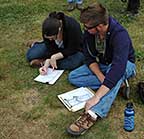
Students working on-site
|
Most teachers are well aware of the various learning styles expressed by students. Remaining cognizant of this in the large population introductory course as well as in the studio is critical to fostering the potential of each student. I provide a variety of ways to contact and assimilate information through listening, reading, writing and doing. This is somewhat easier in the studio where the personality of the student is evident during the one-on-one review of progress and where teaching can be customized to the needs of the individual. Therefore, even in “lecture” courses I assign projects that allow me to meet with individuals or small groups. In the worst case, this role is assumed by teaching assistants instead. |
| |
Each course syllabus states the course objectives and learning outcomes. The knowledge and skills in which students are to be proficient are clearly articulated. The course objectives are also tied back to accreditation requirements and the curriculum objectives adopted by the LArc faculty. Visiting the LArc 380 website or others identified earlier will access examples of syllabi,course calendars, problem statements and course content. |
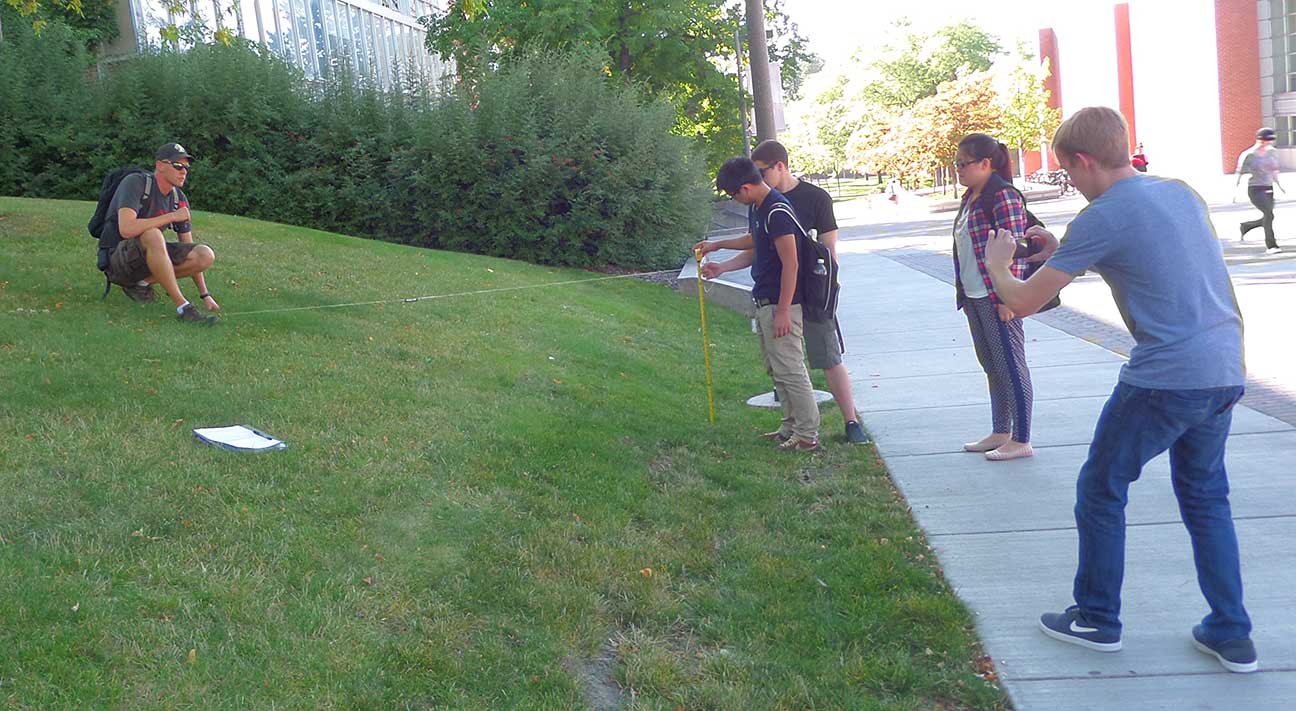 |
I use a variety of methods to assess student proficiency and respond to the diversity of student learning styles. Examinations, group and individual projects and presentations allow for a range of opportunities for students to engage the material. I provide clear project objectives and guidelines for each project assignment and provide students with examples of the final work product. In studio, where there are group components, I use student peer evaluations to assist with my evaluations. |
| |
I stay current in the various aspects of landscape architecture and planning by attending conferences and reading academic and trade publications on a regular basis. My teaching materials are updated before each course with new information and illustrations. I integrate what I learn into my courses so that my courses remain fresh and relevant and include contemporary examples of built work. |
| |
I am able to incorporate my research directly into my courses. The breadth, depth, and international scope of my research allows me to match theory with built work. For example, I have integrated my research on stormwater and wastewater and ecological engineering performance reported in the literature into both technical and planning courses that I teach. The need to tie design concepts to the performance of constructed landscapes helps students develop feasible designs supported by emerging technology. |
| graduate
courses taught |
LArc 556 Graduate Studio. Most recently this was a multi-disciplinary studio
LArc 560 Graduate Studio. I developed this graduate studio to address cultural issues in landscape architecture.
|
undergraduate
courses taught
* team
taught
|
LArc 453 Senior Studio. This course typically address problems of community planning and design for economic, aesthetic and functional revitalization and creation of sustainable public landscapes. This class is merged with Arch 453 to provide interdisciplinary, service learning opportunities.
LArc 455 Senior Studio. Mixed-use high density development is the typical studio topic.
LArc 380 Water Conservation Technologies. This course evolved from the original irrigation design course that I developed for the department. In its current form the class concentrates on water harvesting, stormwater runoff calculations, water pollution treatment with biological methods, green roofs and irrigation design for water conservation.
LArc 389 History of Landscape Architecture. This is a survey course that introduces planning and design from Mesopotamia to contemporary time. I developed this course as a computer assisted course and continue to update the class with new material.
LArc 151* Introduction to the Built Environment. I developed this course with Architecture Professor, Robert Church for delivery to landscape architecture and architecture students. This course has a large student population.
LArc 251 Principles of Site Design. I developed this course many years ago for when the Department of Architecture asked Landscape Architecture to teach this required course for them. I am currently teaching this course again and am revising and updating its contents. The course is now required for students in both disciplines.
LArc 465 Senior Studio. This is the last course in the undergraduate studio sequence. It follows a design development studio. The students take the products from that course and create construction documents intended for their portfolios as they begin their search for professional employment.
LArc 460 Senior Studio. This was the undergraduate thesis course that has been eliminated with the introduction of the Master of Landscape Architecture degree. I was the major professor several undergraduate students each year
LArc 480 Emerging Issues in Landscape Architecture. I have taught this capstone seminar twice.
LArc 268, LArc 269, LArc 368, LArc 368 These are the courses in the construction sequence. It has been several years since I taught these courses.
LArch 210, LAch 247 (now LArc 154 and 310) This is a sequence of computer and manual graphic courses in the program. It has been several years since I have taught these courses
|
theses and graduate projects supervised
Major professor for graduate students in 2013
committee member for graduate students in 2013
|
The number of graduate student projects and theses is increasing as the enrollment in the MLA programs grows. In 2013, I served as the major professor for four students and as a committee member of two others.
Kristin De Boer
Jacob Wachenhut
Tim Garvin
Stan Griswold
Joshua Hail
Joy Campbell
|
public
scholarship courses
|
See the information about LArc 452 and LArc 556 in the teaching discussion above. |
professional
short courses |
Stormwater Treatment for Water Quality Improvement, continuing education credits, Coeur d'Alene, ID. November, 2013
|
| full career cv |
|









